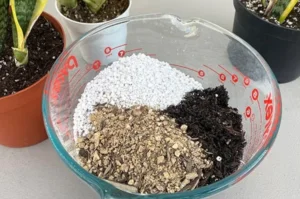Snake plants, scientifically known as Sansevieria, are renowned for their hardiness and ability to thrive with minimal care. However, even the most low-maintenance houseplants need occasional pruning. Pruning maintains their shape, boosts health, and prevents problems as they grow. If you’re new to pruning a snake plant, you might encounter a few issues. Let’s tackle those together!
1. Over-pruning:
It can be tempting to prune your snake plant too frequently, especially if you’re eager to maintain its appearance. However, over-pruning can stress the plant and hinder its growth.
Solution:
Prune a few leaves at a time. Wait for new growth before further trimming. To understand why pruning is necessary and how to avoid overdoing it, check out why we should prune a snake plant.
2. Cutting Leaves Too Short
Cutting snake plant leaves too short can freeze the plant’s ability to photosynthesize and may affect its overall health.
Solution:
When pruning, always leave a few inches of the leaf intact to ensure that the plant can continue to produce energy through photosynthesis. Use sharp, clean scissors or pruning shears to make clean cuts at a slight angle. Learn more about how to prune a snake plant safely.
3. Using Dull or Dirty Tools
Using dull or dirty pruning tools can not only make the pruning process more difficult but can also introduce harmful bacteria or fungi to the plant, increasing the risk of infection.
Solution:
Before pruning your snake plant, make sure your tools are clean and sharp. Wipe them down with a cloth soaked in rubbing alcohol to disinfect them, and sharpen any dull blades to ensure clean cuts. Discover the essential tools for pruning a snake plant.
4. Not Pruning Damaged or Diseased Parts
Neglecting to prune damaged or diseased parts of the plant can allow problems to spread and worsen over time.
Solution:
Regularly inspect your snake plant for signs of damage or disease, such as brown or yellowing leaves, soft spots, or unusual growths. Prune affected areas immediately to prevent further damage. For insights on common challenges, read about the challenges in pruning a snake plant.
5. Removing Healthy Leaves
Sometimes, people mistakenly remove perfectly healthy leaves, thinking they are dead or dying.
Solution:
Take care to only remove leaves that are truly dead or damaged. Healthy leaves play a crucial role in the plant’s photosynthesis and overall health, so it’s important to leave them intact.
6. Pruning at the Wrong Time
Pruning your snake plant at the wrong time can disrupt its natural growth cycle and cause unnecessary stress to the plant.
Solution:
The best time to prune your snake plant is during the spring or summer months when it’s actively growing. Avoid pruning during the fall or winter when the plant is in a dormant state, as this can impede its ability to recover. Learn more about when to prune a snake plant.
7. Improper Pruning Technique
Improper pruning techniques, such as tearing or ripping the leaves instead of making clean cuts, can damage the plant.
Solution:
Always use sharp, clean scissors or pruning shears to make precise cuts when pruning your snake plant. Cut the leaves at a 45-degree angle to promote healing and minimize the risk of infection. Check out how to care for your snake plant after pruning to ensure proper recovery.
Additional Tips for Pruning a Snake Plant
- Always use sharp, clean tools to minimize damage and prevent the spread of disease.
- Trim leaves from the bottom of the plant to encourage new growth and improve its appearance.
- Consider propagating your snake plant from leaf cuttings to create new plants and fill out its pot.
- Provide your snake plant with plenty of indirect sunlight to promote healthy growth and vibrant foliage.






